As an Amazon Associate KitchenwareSets.com earns from qualifying purchases.
13 Zen Japanese Kitchen Decor Ideas for a Calm Home
Feeling overwhelmed by the constant chaos and clutter in your kitchen? If your countertops have become a magnet for mail, gadgets, and everything in between, you’re not alone. A disorganized kitchen can be a source of daily stress, making cooking feel like a chore rather than a joy and turning the heart of your home into a space you want to escape. It’s a common struggle that leaves many of us craving a simpler, more peaceful environment.
Imagine a kitchen that feels calm, open, and effortlessly organized—a space that breathes. This is the essence of Japanese design philosophy. It’s not just about aesthetics; it’s about creating a harmonious environment that promotes mindfulness, simplicity, and a deep connection to nature. We’ve distilled centuries of Japanese design principles and modern decor trends into a simple, actionable guide to help you create a kitchen that’s not just for cooking, but for calming the soul.
A Zen-inspired Japanese kitchen embraces simplicity, minimalism, and a deep connection to nature. It uses natural materials like wood and stone, a muted color palette, and an uncluttered layout to create a calm, harmonious environment that promotes mindfulness and well-being. By focusing on essentialism and thoughtful organization, you can transform your kitchen from a zone of chaos into an oasis of serenity.
13 Zen Japanese Kitchen Decor Ideas for a Calm Home (2025 Update)
Ready to transform your kitchen into a serene and functional oasis? This curated list is based on a deep analysis of authentic Japanese interior design, modern Japandi trends, and practical application for today’s homes. We’ve gathered a comprehensive collection of ideas, from foundational principles like decluttering to specific decorative touches, all designed to be adaptable for any kitchen size or budget. Let’s dive into 13 actionable steps to bring Zen into your home.
1. Embrace Minimalism and Decluttering
The first step is creating a foundation of calm by ruthlessly decluttering. A minimalist approach means keeping only the essential items and ensuring everything has a designated, hidden home, leaving countertops clear and open.
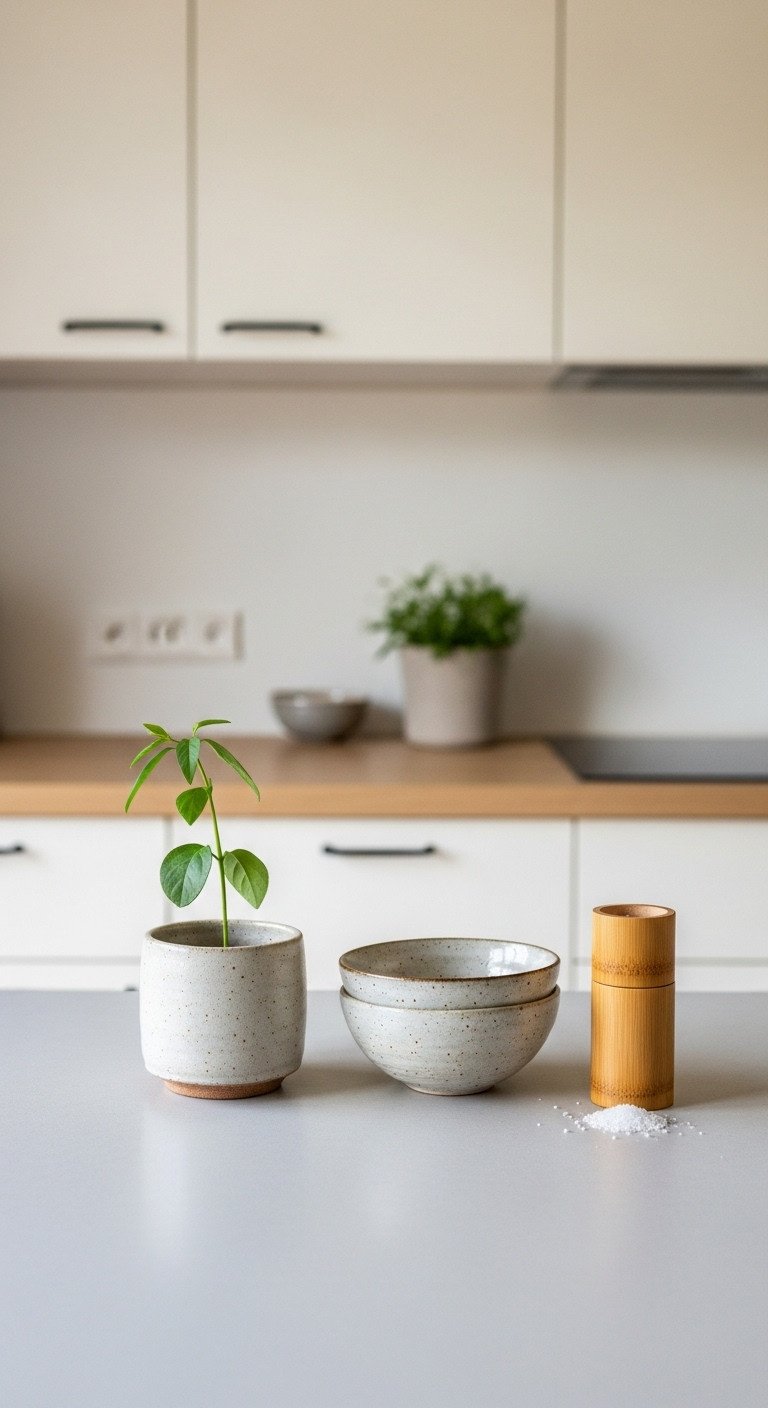
Save this idea to your ‘Minimalist Home’ board!
- Materials Needed: Storage bins, drawer dividers, cleaning supplies.
- Step-by-Step Directions:
- Start by completely clearing one surface, like your countertops.
- Sort every item into three piles: Keep, Donate, or Discard. Be ruthless.
- For the ‘Keep’ pile, assign a specific home for each item inside a cabinet or drawer. The goal is to keep countertops as clear as possible.
- Invest in smart storage solutions to maximize space. High-quality bamboo drawer dividers are excellent for organizing utensils, while vertical pan organizers can transform a messy cabinet.
- Follow the “one in, one out” rule to prevent future clutter.
Pro-Tip: The KonMari method is a great framework for this process. Ask yourself if each item “sparks joy.” If not, it may be time to let it go.
2. Prioritize Natural Materials
To create a connection to the outdoors, prioritize materials that come from the earth. Incorporating wood, bamboo, stone, and natural fibers like linen and cotton adds warmth, texture, and an organic feel to the space.
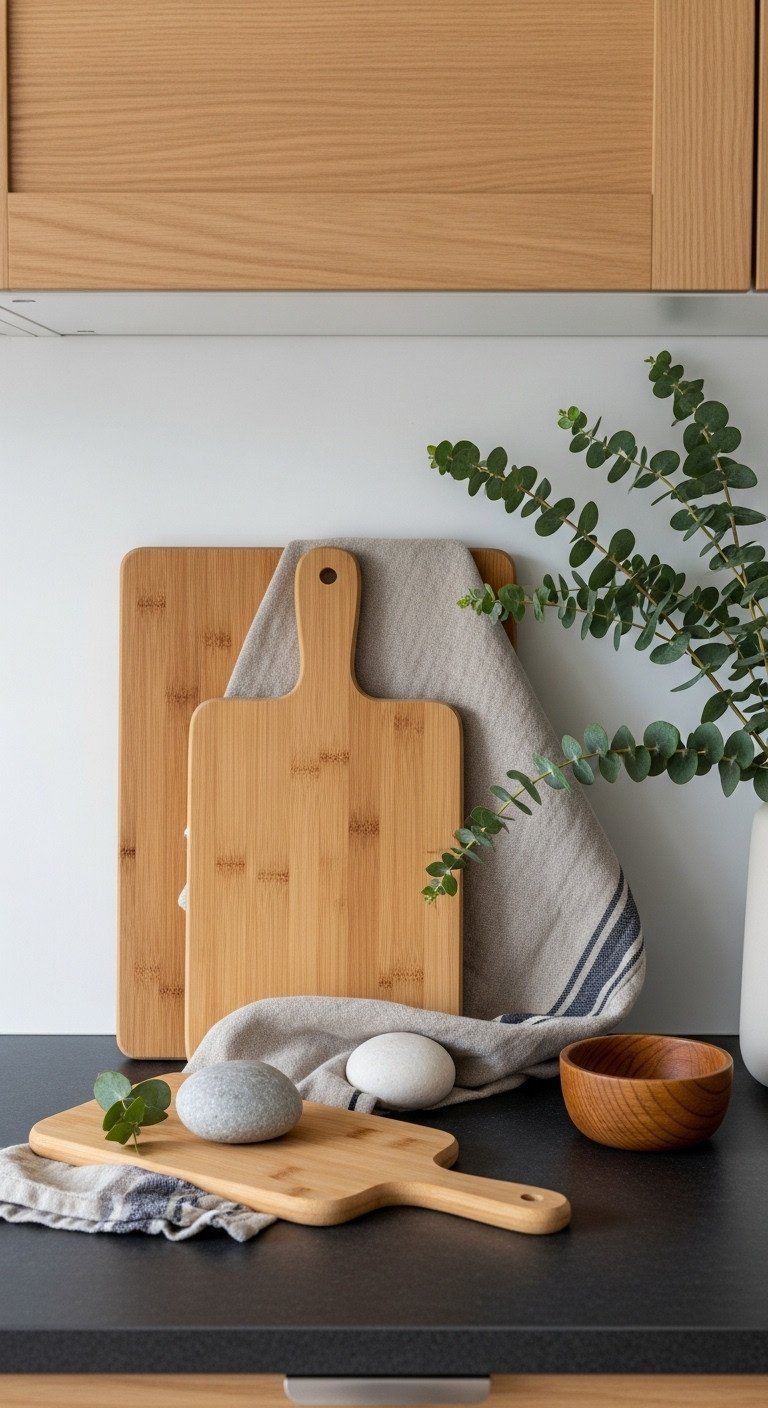
Save this natural texture inspiration to your ‘Kitchen Design’ board!
- Materials Needed: Wooden cutting boards, bamboo utensils, linen towels, stone coasters or mortar and pestle.
- Step-by-Step Directions:
- Swap out plastic cutting boards for high-quality bamboo or light oak versions. They are durable and add warmth.
- Replace synthetic dish towels with natural fibers. A set of simple, high-quality linen or cotton tea towels in a neutral color is perfect.
- Display a beautiful wooden utensil holder on the counter.
- If a full remodel isn’t possible, introduce stone through accessories like a marble or granite mortar and pestle or slate serving boards.
Pro-Tip: Look for woods with a fine, straight grain like hinoki cypress or maple for an authentic Japanese feel.
3. Adopt a Muted, Earthy Color Palette
A Japanese-inspired kitchen uses a color palette drawn from nature to create a serene backdrop. Think warm, neutral tones like sand, beige, cream, and soft gray, which foster a calm and inviting atmosphere.
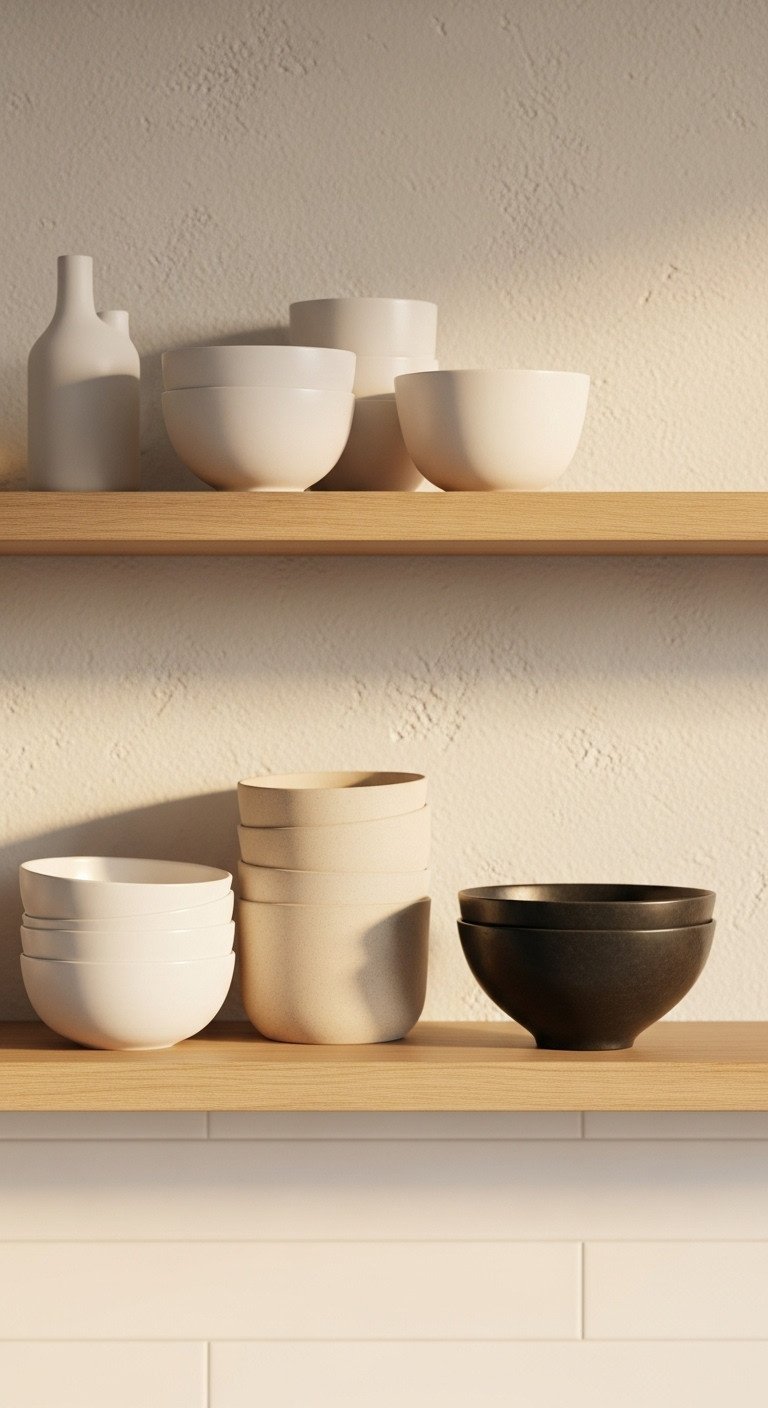
Pin these serene colors for your next kitchen project!
- Materials Needed: Paint swatches, ceramic canisters, neutral-toned textiles.
- Step-by-Step Directions:
- Choose a primary warm neutral color for your walls, such as a soft beige, greige, or off-white.
- If painting cabinets, opt for a light wood finish or a creamy white.
- Layer different shades of the same neutral family through your accessories. Look for high-quality ceramic canisters in shades of sand, cream, and ivory to store dry goods.
- Introduce a single, powerful accent color like black or charcoal through small details like cabinet pulls, a faucet, or a single piece of pottery to create depth and contrast.
Lesson Learned: Always test paint samples on your wall in different lighting conditions (morning, afternoon, artificial light) before committing to a color.
4. Maximize Natural Light and Openness
The goal is to create a bright, airy space by making the most of available natural light. This enhances the feeling of openness and connects the indoor space with the outside world, a key principle in Japanese design.
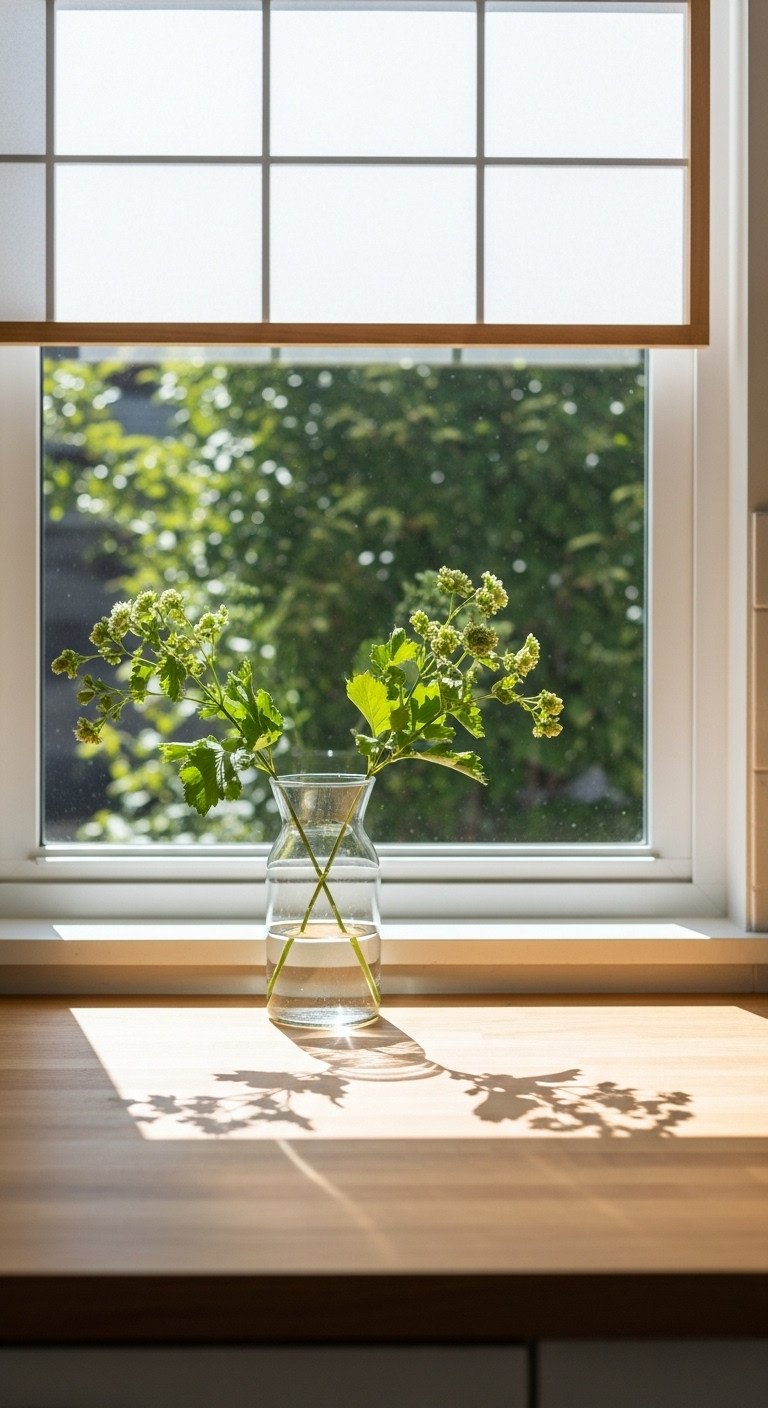
Save this bright and airy kitchen idea to your dream home board!
- Materials Needed: Light-filtering curtains or blinds, window cleaning solution, mirrors.
- Step-by-Step Directions:
- Remove heavy, dark curtains or blinds. Replace them with options that diffuse light softly.
- A great DIY option is to use a high-quality rice paper window film which mimics the look of traditional shoji screens without the high cost.
- If you have a window, keep the sill clear of clutter to allow maximum light to enter.
- Clean your windows inside and out regularly—you’ll be surprised how much brighter the room feels.
- Strategically place a mirror on a wall opposite a window to reflect light back into the space.
Pro-Tip: If you’re planning a remodel, consider extending your countertop past the window to create a seamless indoor-outdoor connection.
5. Integrate Greenery and Natural Accents
Bringing living elements into the kitchen adds life, freshness, and a direct touch of nature. This can be done through carefully chosen plants or arrangements that emphasize form and simplicity, like bonsai or Ikebana.
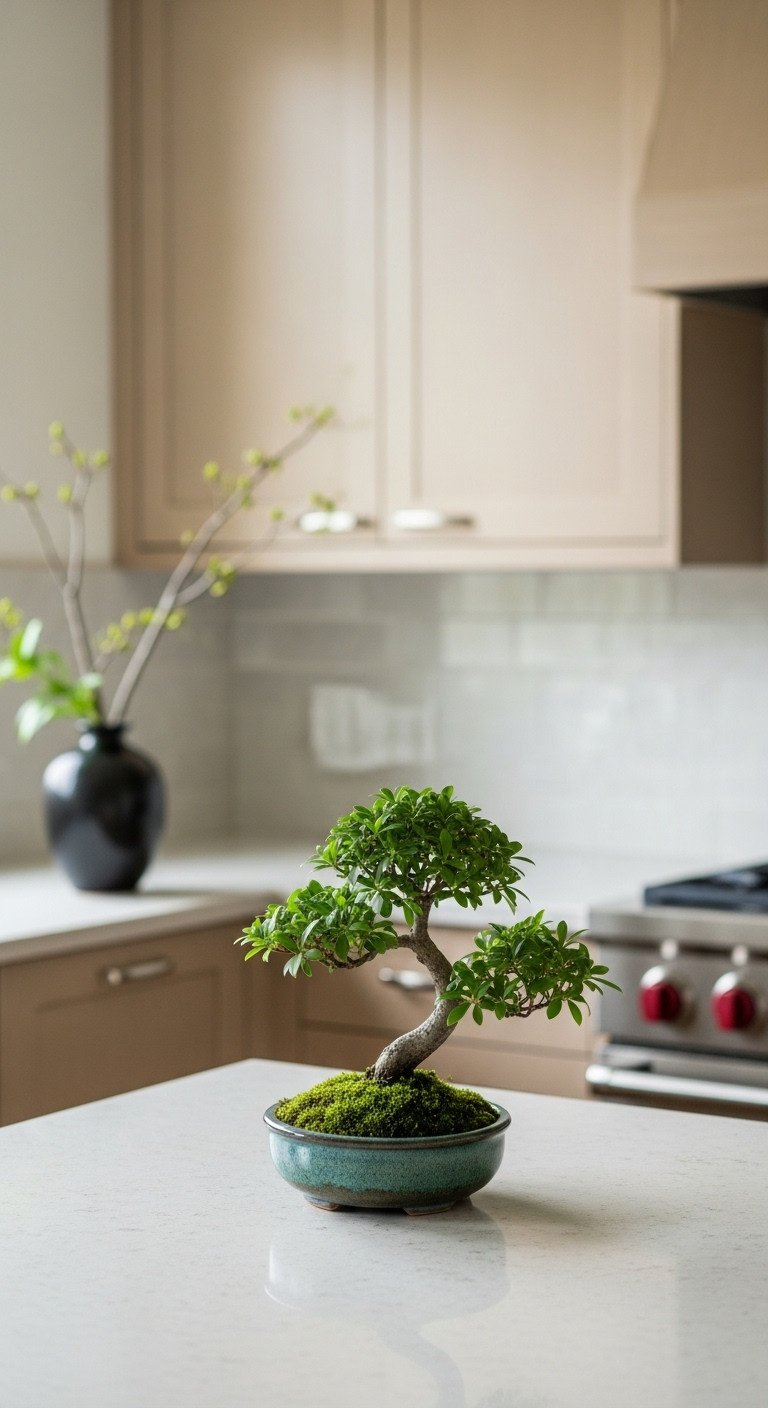
Pin this touch of nature for a calming kitchen vibe!
- Materials Needed: Indoor plant (e.g., small bonsai, pothos, or orchid), ceramic planter, Ikebana Kenzan (flower frog).
- Step-by-Step Directions:
- Choose a plant that suits your kitchen’s light conditions. A small bonsai can be a stunning focal point on a counter or shelf.
- For a simpler touch, place a single, elegant branch (like cherry blossom or curly willow) in a tall, minimalist vase.
- Try a simple Ikebana arrangement. All you need is a shallow dish, a kenzan (a spiky ‘frog’ to hold stems), and a few interesting flowers or branches. The focus is on form, line, and asymmetry.
- Ensure your plant is in a beautiful, simple pot made of natural material like ceramic or terracotta.
Lesson Learned: Don’t overcrowd with plants. The Japanese principle is about one or two carefully chosen elements that make a statement, rather than a dense jungle.
6. Choose Simple, Functional Furniture
Furniture and cabinetry should emphasize clean lines, simple forms, and seamless functionality. The design should be unobtrusive, with features like handleless cabinets and low-profile seating that maintain an uncluttered aesthetic.
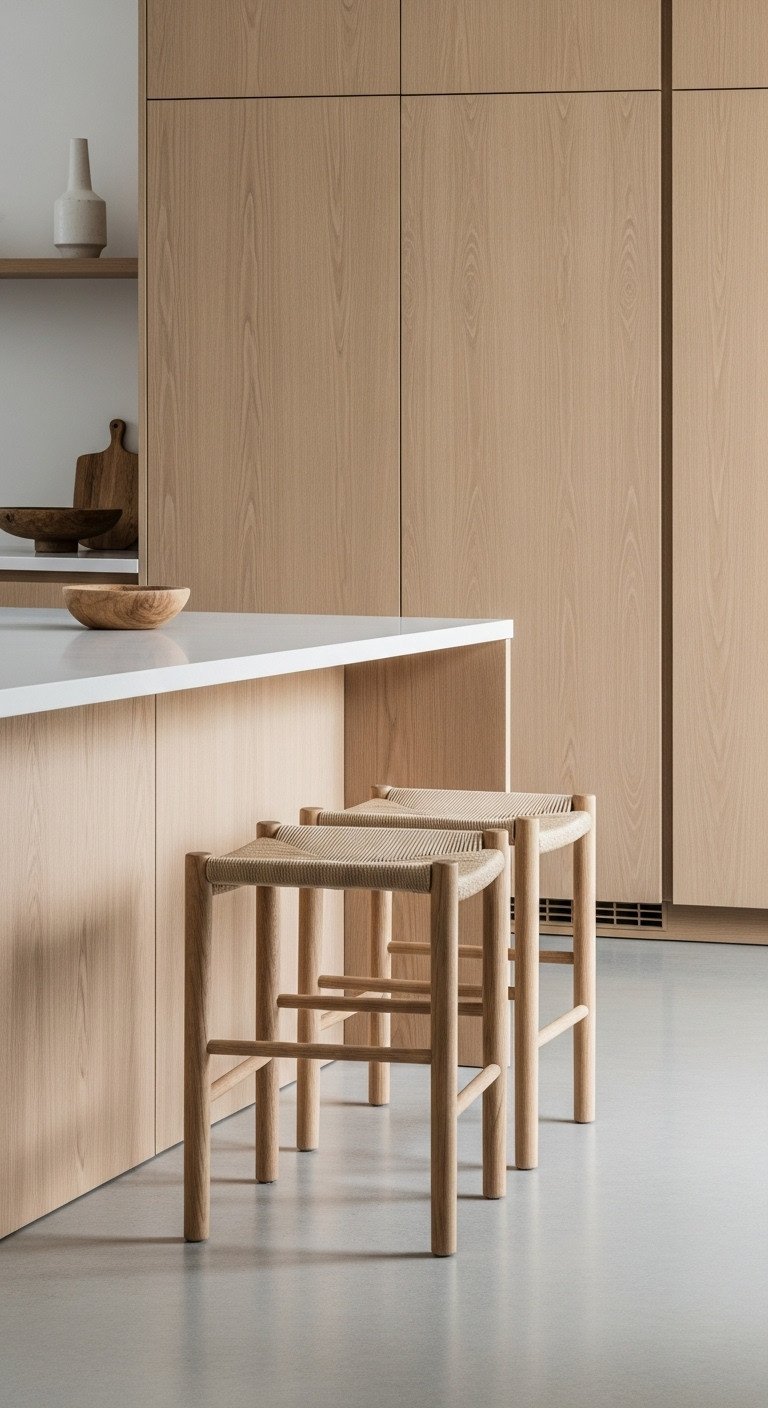
Save this minimalist furniture inspiration for a clean look!
- Materials Needed: Handleless cabinet hardware kit (push-to-open or channel pulls), simple wooden stools.
- Step-by-Step Directions:
- If renovating, choose flat-panel cabinet doors for a seamless look.
- For an easy update, replace existing cabinet handles with minimalist hardware. Consider edge pulls that mount to the back of the door or a push-to-open hardware system for a completely handleless appearance.
- Opt for seating with simple forms and natural materials, such as a wooden bench or low-profile stools that can be tucked away.
- Prioritize built-in storage and appliances to maintain a sleek, unbroken visual line.
Pro-Tip: The concept of “zen” (line of path) is key. Arrange your furniture and functional zones (prep, cook, clean) logically to minimize unnecessary movement and create a natural flow.
7. Thoughtful Lighting Design
The right lighting can transform the mood of a room from harsh and functional to soft and serene. Avoid bright, central overhead lights in favor of layered, diffused lighting that creates a warm and intimate ambiance.
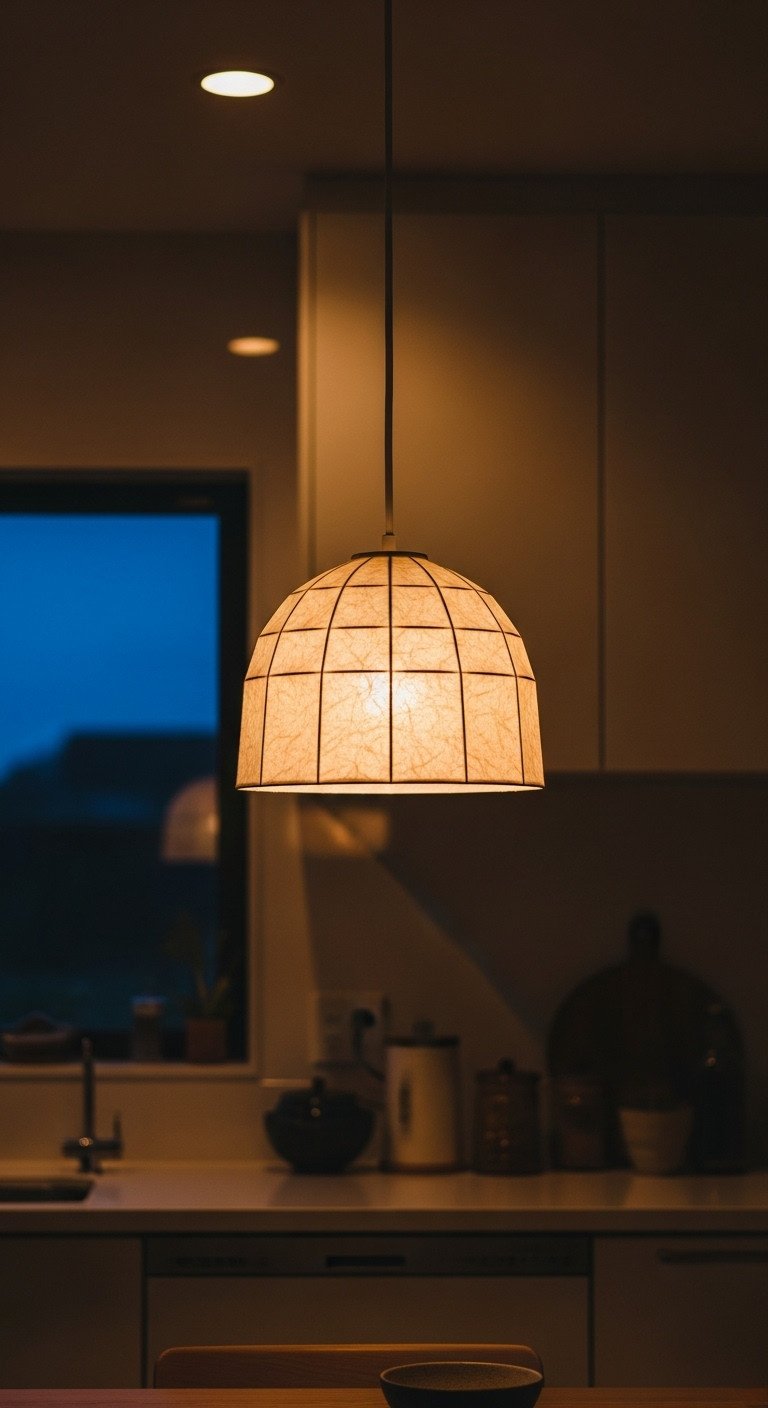
Pin this beautiful lighting idea for a cozy kitchen atmosphere!
- Materials Needed: Pendant light with natural shade, dimmer switch, under-cabinet LED strips.
- Step-by-Step Directions:
- Replace harsh central ceiling lights with softer alternatives. A pendant light made from rice paper, washi paper, linen, or woven bamboo over an island or dining area is a perfect centerpiece.
- Install dimmer switches on your main light sources. This gives you complete control over the brightness and mood of the room.
- Add task lighting where you need it most. Warm-toned under-cabinet LED light strips are a great way to illuminate countertops for food prep without flooding the whole room with light.
- Choose light bulbs with a warm temperature (2700K-3000K) to enhance the cozy, serene feeling.
Lesson Learned: Layering your lighting is key. Combine ambient (overall), task (focused), and accent (decorative) lighting to create a functional yet atmospheric space.
8. Incorporate Handcrafted Accessories
To add personality and warmth, choose a few unique, handcrafted items that tell a story. This embraces the Japanese concept of “wabi-sabi”—finding beauty in imperfection, and it adds a human touch to a minimalist space.

Save this wabi-sabi inspiration for your kitchen!
- Materials Needed: Handmade ceramic pieces, wooden cooking spoons, linen napkins, Kintsugi repair kit.
- Step-by-Step Directions:
- Visit local craft markets or online artisan shops to find unique, handmade ceramic mugs or bowls. The slight imperfections are part of their charm (wabi-sabi).
- Replace plastic cooking utensils with a set of beautiful, functional wooden or bamboo spoons and spatulas.
- Instead of paper towels, use a set of high-quality linen napkins for meals.
- For a truly unique piece, you can even try the art of Kintsugi, the Japanese art of repairing broken pottery with gold lacquer. You can use a DIY Kintsugi repair kit on a cherished but broken ceramic item.
Pro-Tip: Choose items that are not only beautiful but also functional. A handcrafted teapot or a beautifully carved wooden serving spoon brings art into everyday tasks.
9. Utilize Open Shelving Strategically
Open shelving can add visual interest and lightness, but it must be used with intention. The key is to treat it as a display for a few beautiful, curated items rather than a catch-all for everyday storage.
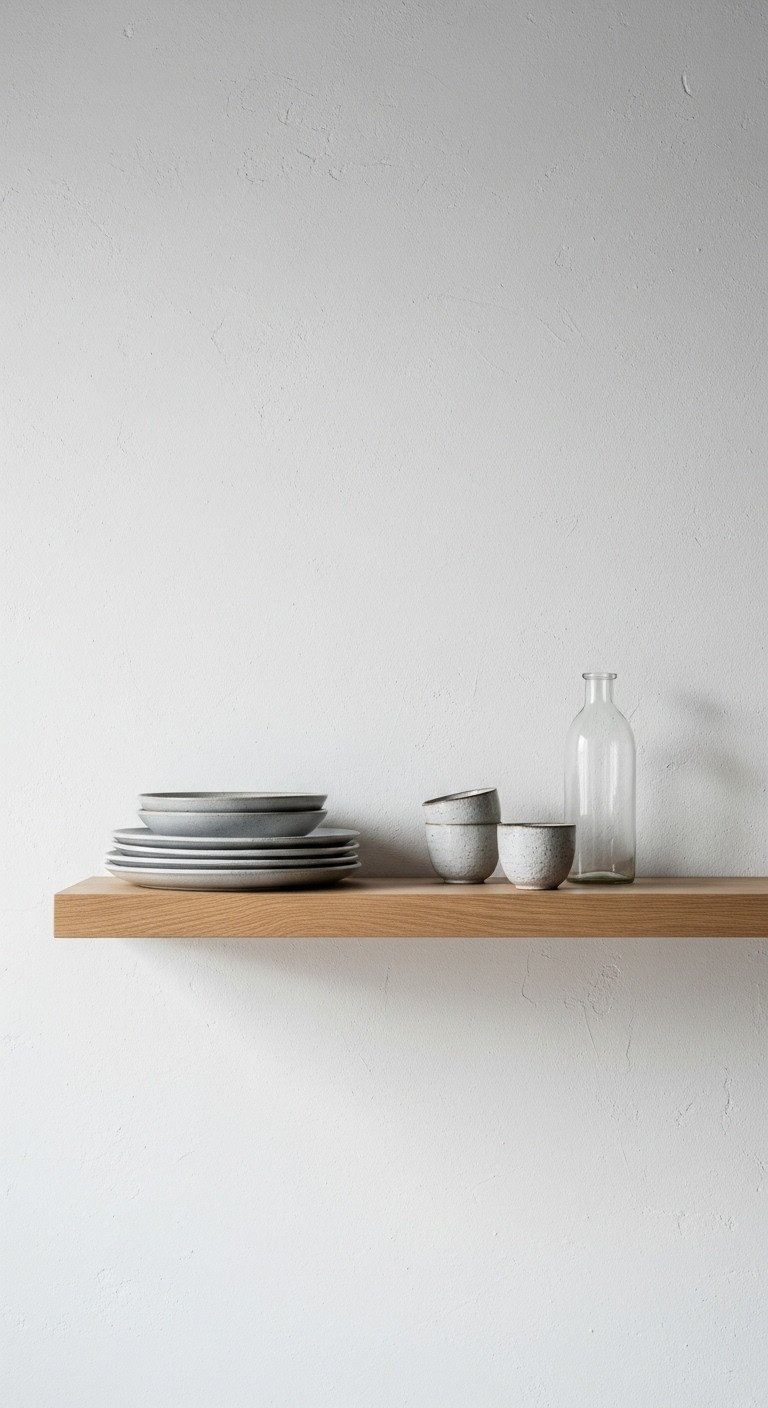
Love this clean look? Pin this open shelving idea!
- Materials Needed: Floating wood shelves, heavy-duty wall anchors, level, drill.
- Step-by-Step Directions:
- Choose one or two high-quality floating shelves made of natural wood. Avoid cluttering a whole wall with them.
- Install the shelves using heavy-duty floating shelf brackets or anchors to ensure they can safely hold ceramic dishes.
- This is for display, not storage. Select only your most beautiful and cohesive items: matching ceramic plates, a special teapot, or simple glassware.
- Leave plenty of negative space around each item or group of items. The goal is to create a calm, gallery-like feel, not to pack the shelf full.
Lesson Learned: Less is more. If the shelf starts to look crowded, take everything off and start again with half the number of items.
10. Opt for Seamless Built-in Appliances
To achieve a truly minimalist and uncluttered look, conceal appliances behind cabinetry. This creates a smooth, uninterrupted visual flow and hides the visual noise of technology, enhancing the kitchen’s serene atmosphere.
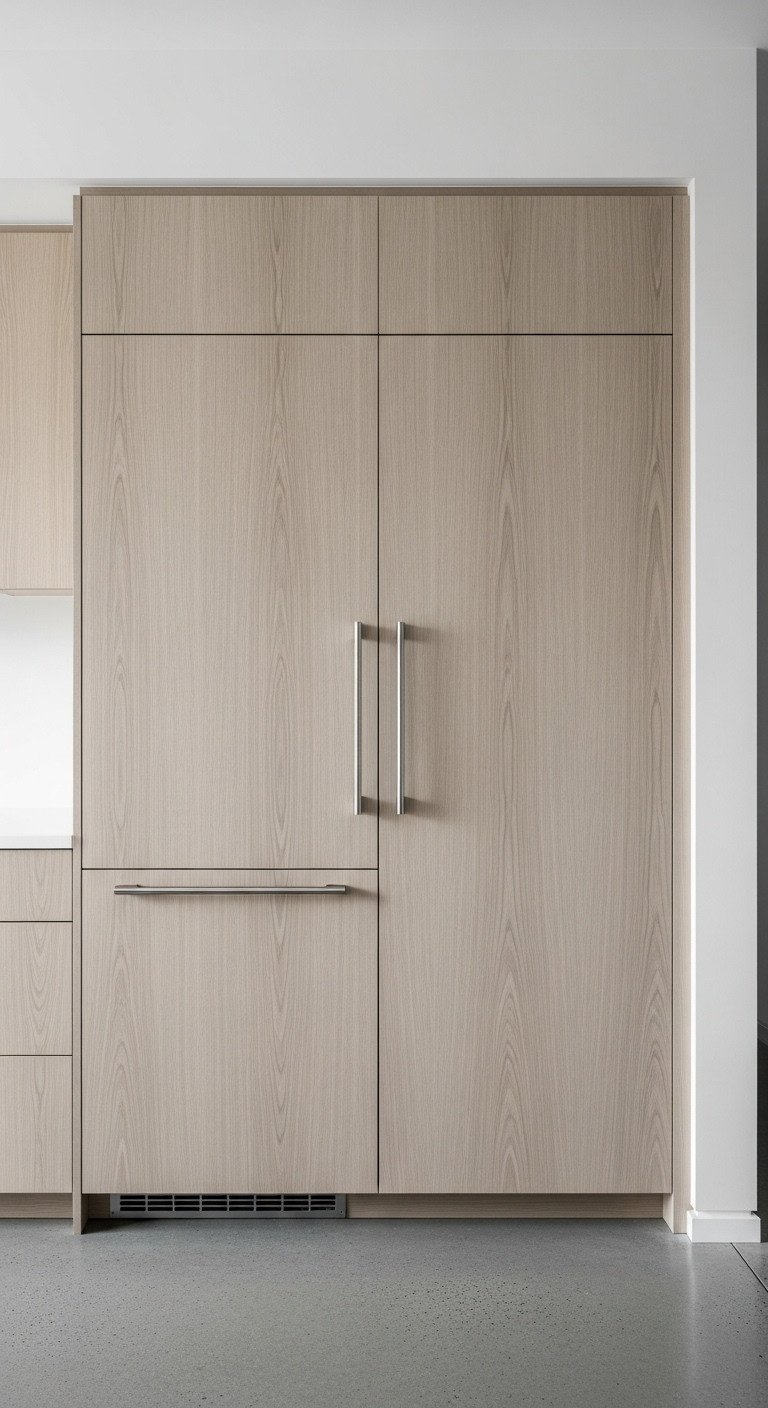
Pin this ultra-sleek kitchen design for major inspiration!
- Materials Needed: Panel-ready appliances (for remodels), appliance garage cabinet, small countertop appliances in neutral colors.
- Step-by-Step Directions:
- If you’re planning a major renovation, investing in panel-ready appliances that can be faced with your custom cabinetry is the ultimate way to achieve a seamless look.
- A more budget-friendly approach is to create an “appliance garage”—a cabinet with a lift-up or sliding door that sits on the countertop to hide items like toasters and blenders.
- When purchasing smaller countertop appliances like a kettle or coffee maker, choose models with minimalist designs and neutral colors (white, black, or stainless steel) that blend in rather than stand out.
Pro-Tip: Look for appliances with flat, non-protruding handles or touch-to-open mechanisms to further enhance the seamless, integrated appearance.
11. Layer Natural Textures
In a neutral space, texture is essential for adding depth, warmth, and visual interest. Layering different natural textures—smooth wood, rough stone, soft linen, coarse woven fibers—creates a rich, tactile experience without adding clutter.
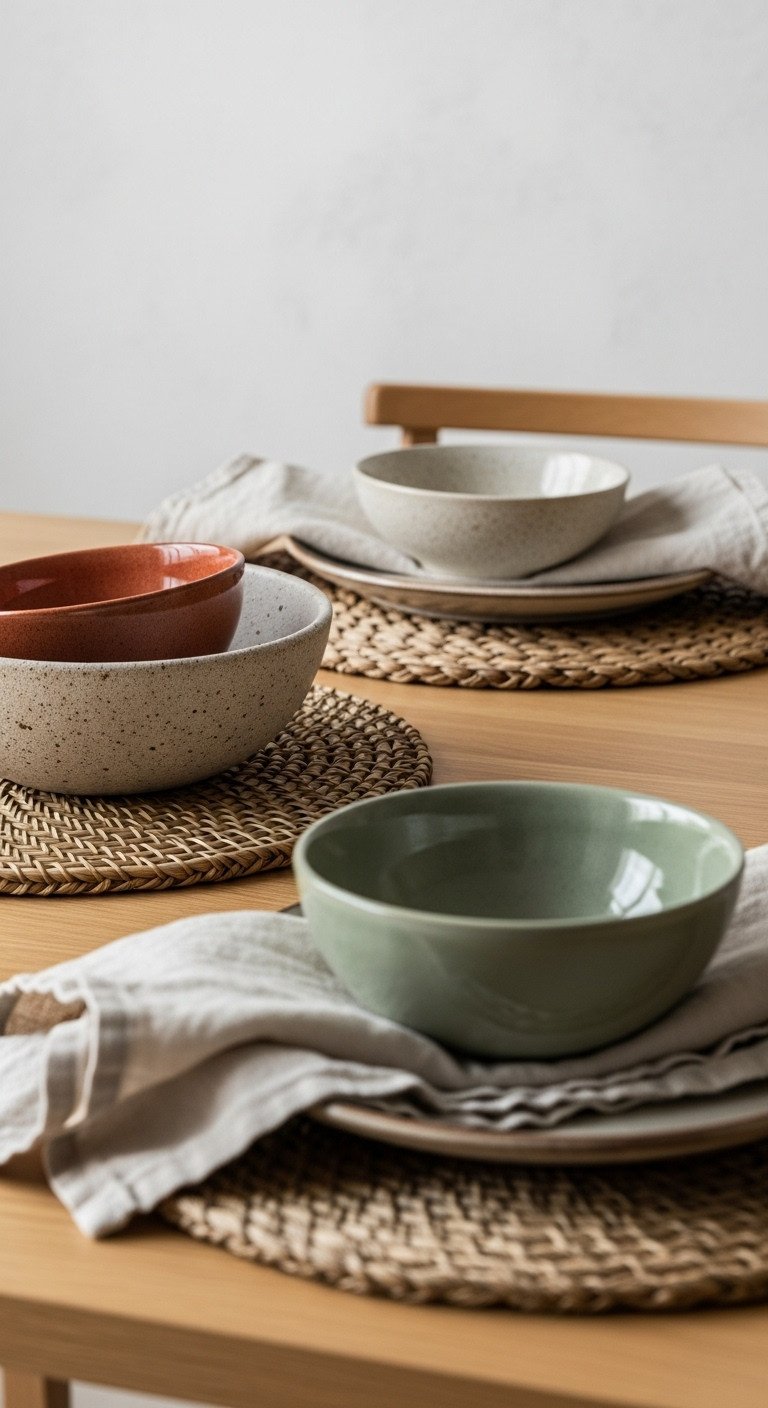
Save this beautiful texture combination for a cozy, minimalist kitchen!
- Materials Needed: Woven placemats (seagrass, jute, or rattan), linen napkins or tea towels, stone or wood serving board.
- Step-by-Step Directions:
- Start with a smooth base, like your wooden table or stone countertop.
- Introduce a coarse, woven texture. Natural fiber placemats, like those made from seagrass or water hyacinth, are perfect for adding tactile interest during meals.
- Add a soft texture with high-quality linen napkins or a cotton table runner.
- Incorporate a rough or matte texture with unglazed ceramic pottery or a rustic wooden serving board.
- The key is to vary the textures while keeping the color palette consistent and neutral.
Pro-Tip: Even the walls can be a source of texture. Consider a limewash or tadelakt plaster finish for a soft, matte texture that beautifully reflects light.
12. Add a Modern Shoji Screen Element
Incorporate a traditional Japanese architectural element, like a shoji screen, in a modern way. These translucent screens can be used as pantry doors, cabinet fronts, or room dividers to add an authentic touch while beautifully diffusing light.
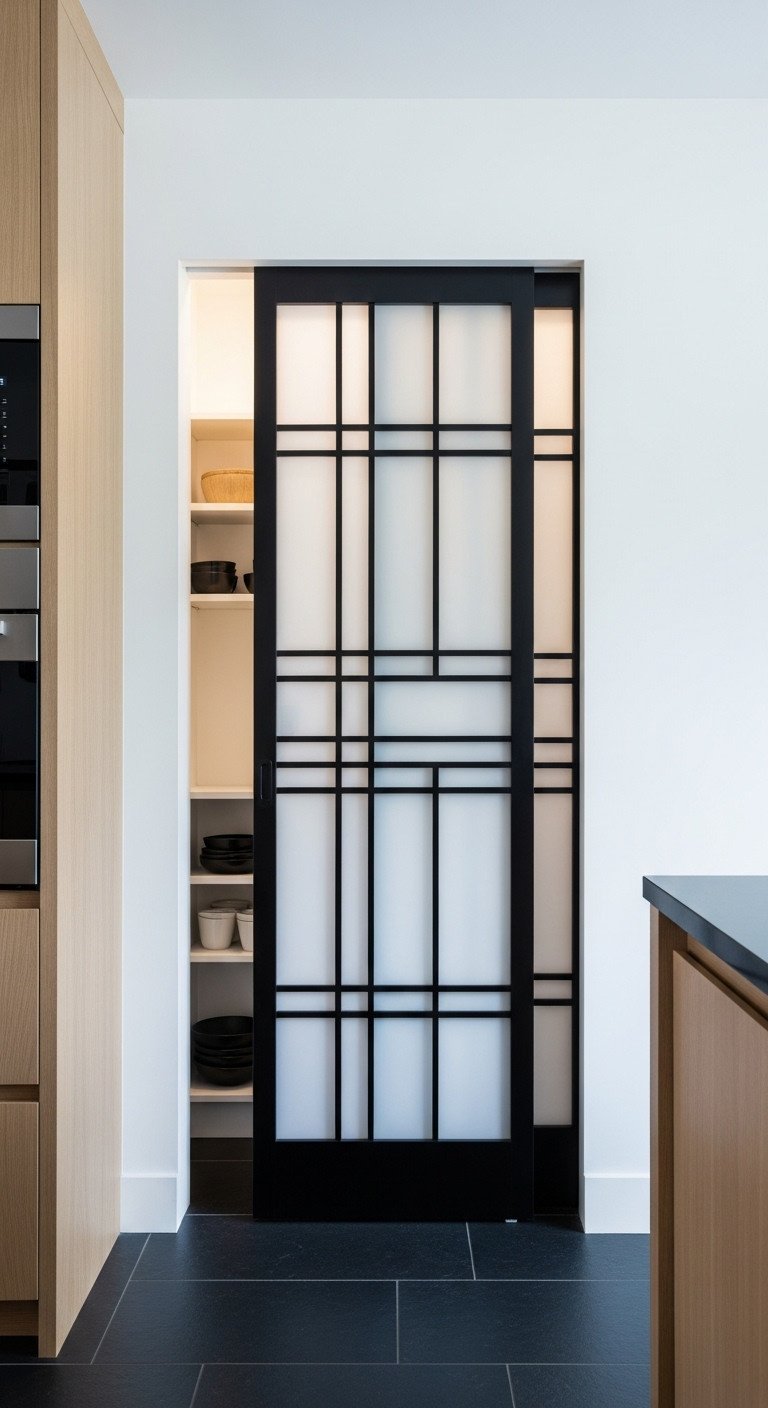
Pin this brilliant modern take on a traditional Japanese element!
- Materials Needed: Freestanding shoji screen, or materials for a custom build (wood, translucent panels).
- Step-by-Step Directions:
- An easy way to incorporate this element is with a freestanding shoji screen room divider. You can use it to visually separate the kitchen from a dining area or to hide a cluttered corner.
- For a more integrated look, consider using a shoji-style screen as a pantry door or a cabinet front.
- A DIY approach involves building a simple wooden frame and fitting it with frosted acrylic or plexiglass panels to mimic the look of rice paper with more durability for a kitchen environment.
Lesson Learned: Authentic shoji screens use delicate washi paper, which may not be practical for a high-traffic kitchen. Modern materials like frosted glass or durable acrylic can provide the same aesthetic with better longevity.
13. Embrace the Japandi Style
The Japandi style offers a perfect fusion of Japanese minimalism and Scandinavian warmth. This hybrid approach combines the clean lines and functionality of Japanese design with the cozy, rustic elements of Scandinavian decor, creating a space that is both minimalist and inviting.
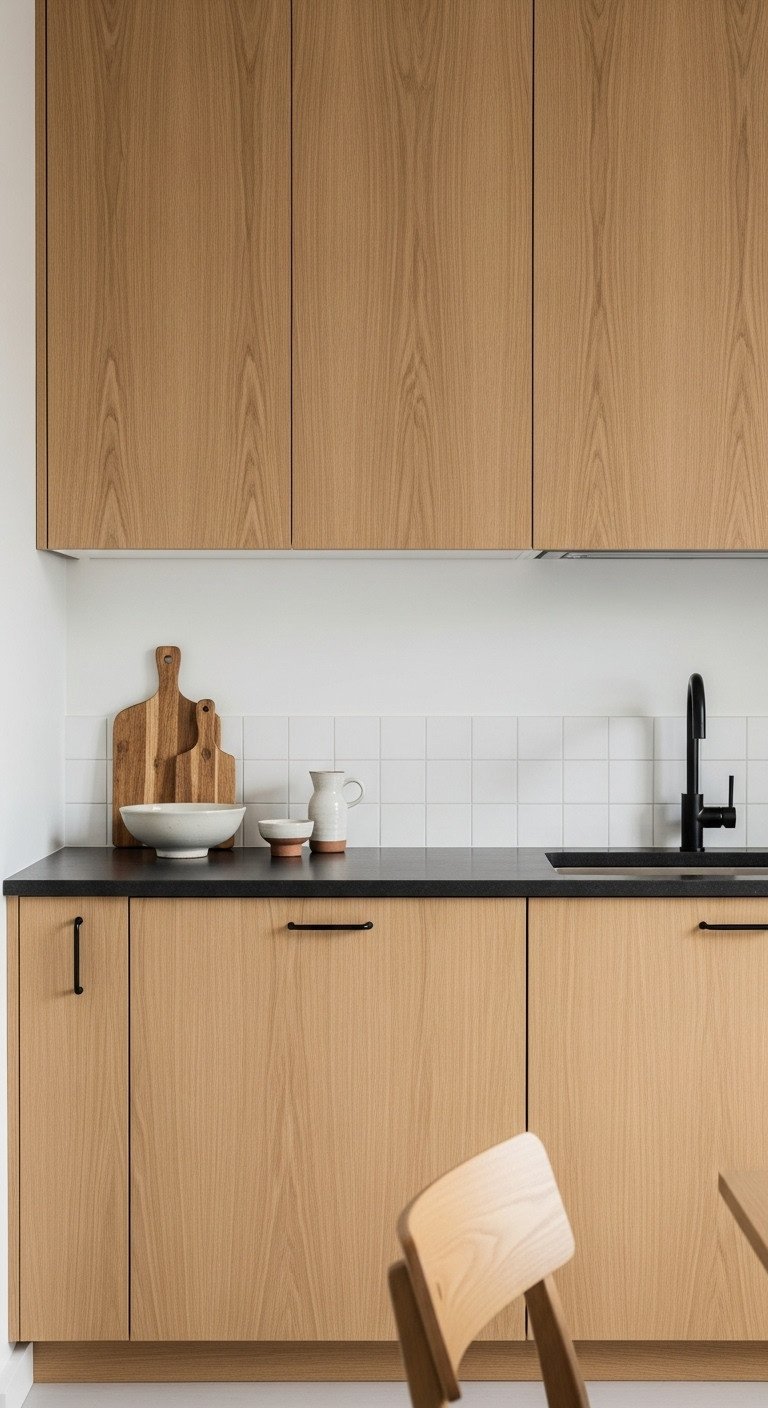
Save this perfect Japandi kitchen for your ultimate design goals!
- Materials Needed: Light wood accessories, matte black fixtures, textured neutral textiles, simple ceramics.
- Step-by-Step Directions:
- Combine different wood tones. Use light woods like oak or ash (Scandinavian influence) alongside darker or richer woods like walnut (Japanese influence).
- Maintain a neutral color palette but ensure it feels warm and inviting, not stark.
- Focus on high-quality, functional pieces. A simple yet elegant matte black kitchen faucet can be a perfect Japandi statement piece.
- Incorporate cozy textures, a key element of Scandinavian “hygge,” through soft linen towels, wool seat cushions, or a small woven rug.
Pro-Tip: The key to Japandi is the contrast. Contrast smooth surfaces with rough textures, light woods with dark accents, and straight lines with organic shapes.
@kaerukeki Replying to @Diana My Home Goods haul from LA!!! I did kinda overspend, but when I buy something I always think about whether I’ll use it in the future—and I can see myself using these items till the day I die 🙂↕️ (trying to justify my purchases lolol) . #kitchenhaul#homedecor#kitchenwares#haul#interiordecor
Key Takeaways: Your Quick Guide to Japanese Kitchen Decor
- Less is More: The foundation is a decluttered, minimalist space. Keep countertops clear and ensure every item has a purpose and a place.
- Connect with Nature: Heavily feature natural materials like wood, bamboo, and stone. Bring the outdoors in with a carefully chosen plant or branch.
- Embrace a Calm Palette: Stick to warm, earthy, and neutral colors like beige, cream, and soft grays. Use black sparingly for contrast.
- Prioritize Soft Light: Maximize natural daylight with sheer coverings and use soft, diffused artificial lighting (like paper lanterns) to create a serene mood.
- Value Craftsmanship: Add warmth and personality with a few thoughtfully selected handcrafted items, celebrating the beauty of imperfection (wabi-sabi).
People Also Ask About Japanese Kitchen Decor
What is a Japanese style kitchen?
A Japanese style kitchen is characterized by minimalism, functionality, and a strong connection to nature. It features natural materials like wood and stone, a neutral color palette, uncluttered surfaces, and an emphasis on creating a calm, harmonious, and efficient workspace. The design prioritizes simplicity and clean lines over ornamentation.
What is Japanese style decor called?
Japanese style decor is often referred to by several concepts. “Wabi-sabi” emphasizes the beauty of imperfection and nature. “Shibui” refers to a simple, subtle, and unobtrusive beauty. More recently, the hybrid style “Japandi” has become very popular, which blends Japanese minimalism with Scandinavian warmth and functionality (hygge).
How do I make my kitchen look Japanese?
To make your kitchen look Japanese, start by decluttering completely. Incorporate natural materials like bamboo cutting boards and wooden utensils. Switch to a neutral color palette of whites, beiges, and grays. Add a touch of nature with a single plant or branch. Finally, choose simple, functional accessories and consider soft, diffused lighting.
Final Thoughts
Creating a Zen Japanese-inspired kitchen is more than a design choice; it’s about crafting a sanctuary in the heart of your home. By embracing these principles of simplicity and nature, you can transform your kitchen into a space that not only functions beautifully but also calms your mind and nourishes your spirit.
Which of these serene ideas are you most excited to bring into your kitchen? Let us know in the comments below.
Last update on 2025-10-15 at 11:19 / Affiliate links / Images from Amazon Product Advertising API
